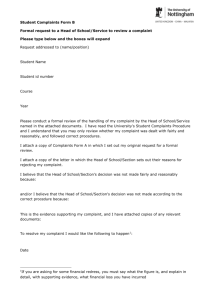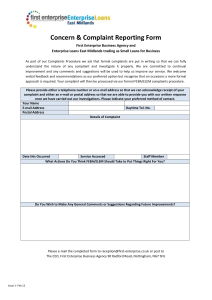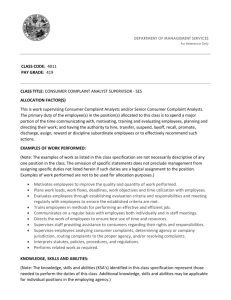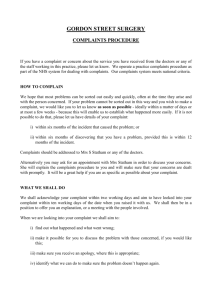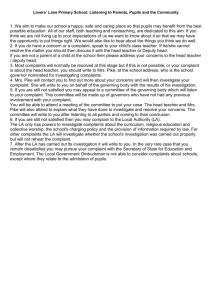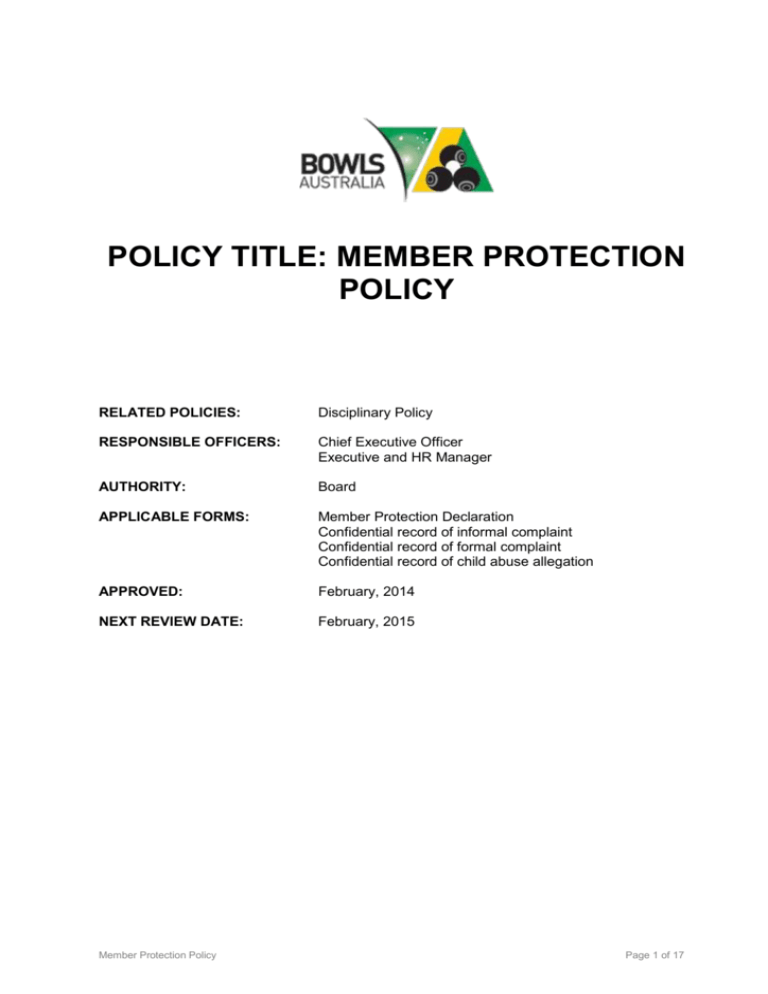
POLICY TITLE: MEMBER PROTECTION
POLICY
RELATED POLICIES:
Disciplinary Policy
RESPONSIBLE OFFICERS:
Chief Executive Officer
Executive and HR Manager
AUTHORITY:
Board
APPLICABLE FORMS:
Member Protection Declaration
Confidential record of informal complaint
Confidential record of formal complaint
Confidential record of child abuse allegation
APPROVED:
February, 2014
NEXT REVIEW DATE:
February, 2015
Member Protection Policy
Page 1 of 17
Contents
PART A – MEMBER PROTECTION POLICY
1. Purpose of this policy
2. Who is bound by this policy?
3. Organisational responsibilities
4. Individual responsibilities
5. Dictionary
6. Position statements
7.
8.
9.
6.1
Child protection
6.2
Taking of images of children
6.3
Anti-discrimination and harassment
6.4
Sexual relationships
6.5
Pregnancy
6.6
Gender identity
6.7
Responsible service and consumption of alcohol
6.8
Smoke-free environment
6.9
Cyber bullying
6.10 Social networking sites
Complaints procedures
7.1
Handling complaints
7.2
Vexatious complaints and victimisation
7.3
Mediation
7.4
Tribunals
What is a breach of this policy?
Disciplinary measures
9.1
Individuals
9.2
Organisations
9.3
Factors to consider
PART B – ATTACHMENTS: CODES OF BEHAVIOUR
B1. Coaches Code of Behaviour
B2. Officials Code of Behaviour
PART C – ATTACHMENTS: EMPLOYMENT SCREENING/WORKING WITH
CHILDREN CHECK REQUIREMENTS
C1. Employment screening requirements
C2. Member Protection Declaration
C3. Working with Children Check requirements
PART D – ATTACHMENTS: COMPLAINT HANDLING PROCEDURES
D1. Mediation
PART E – ATTACHMENTS: REPORTING REQUIREMENTS AND DOCUMENTS
E1.
E2.
E3.
E4.
Confidential record of informal complaint
Confidential record of formal complaint
Procedure for handling allegations of child abuse
Confidential record of child abuse allegation
Member Protection Policy
Page 2 of 17
PART A: NATIONAL MEMBER PROTECTION POLICY
1. Purpose of this policy
1.1. This Member Protection Policy (“policy”) aims to assist Bowls Australia (BA) to uphold
its core values and create a safe, fair and inclusive environment for everyone
associated with our sport. It sets out our commitment to ensure that every person
involved in our sport is treated with respect and dignity and protected from
discrimination, harassment and abuse. It also ensures that everyone involved in
our sport is aware of their legal and ethical rights and responsibilities, as well as
the standards of behaviour expected of them.
1.2. The policy attachments describe the practical steps we will take to eliminate
discrimination, harassment, child abuse and other forms of inappropriate
behaviour from our sport. As part of this commitment, BA will take disciplinary
action against any person or organisation bound by this policy if they breach it.
1.3. This policy has been endorsed by the BA Board and has the policy starts on February
4, 2014 and will operate until replaced.
1.4. The current policy and its attachments can be obtained from our website,
www.bowlsaustralia.com.au.
2. Who is bound by this policy
2.1. This policy applies to the following people, whether they are in a paid or
unpaid/voluntary capacity:
2.1.1.persons appointed or elected to boards, committees and sub-committees;
2.1.2.employees of BA;
2.1.3.members of the BA Board;
2.1.4.support personnel, including managers, physiotherapists, psychologists,
masseurs, sport trainers and others;
2.1.5.coaches and assistant coaches;
2.1.6.athletes
2.1.7.officials, umpires and other officials
2.1.8.members, including Life Members of BA;
2.1.9.athletes, coaches, officials and other personnel participating in events and activities,
including camps and training sessions, held or sanctioned by BA.
2.2. This policy will continue to apply to a person even after he or she has stopped their
association or employment with BA if disciplinary action against that person has
begun.
2.3. This policy also applies to all membership categories listed within the BA Constitution,
including:
2.3.1. member states;
2.3.2. Associate Members;
2.3.3. Individual Members;
2.3.4. Organisational Members.
3. Organisational responsibilities
Bowls Australia and Member States must:
3.1. adopt, implement and comply with this policy
3.2. ensure that the Constitution, By-laws or other rules and policies include the necessary
clauses for this policy to be enforceable
3.3. publish, distribute and promote this policy and the consequences of any breaches
3.4. promote and model appropriate standards of behaviour at all times
3.5. deal with any breaches or complaints made under this policy in a sensitive, fair, timely
and confidential manner
Member Protection Policy
Page 3 of 17
3.6. apply this policy consistently
3.7. recognise and enforce any penalty imposed under this policy
3.8. ensure that a copy of this policy is available or accessible to all people and
organisations to whom this policy applies
3.9. use appropriately trained people to receive and manage complaints and allegations of
inappropriate behavior - Member Protection Information Officers
3.10. monitor and review this policy at least annually.
4. Individual responsibilities
4.1. Individuals bound by this policy are responsible for:
4.1.1.making themselves aware of the policy and complying with the codes of
behaviour it sets out
4.1.2.consenting to our screening requirements and any state/territory Working with
Children Checks if the person holds or applies for a role that involves regular
unsupervised contact with a child or young person under the age of 18
4.1.3.placing the safety and welfare of children above other considerations
4.1.4.being accountable for their behaviour
4.1.5.following the steps outlined in this policy for making a complaint or reporting
possible child abuse
4.1.6.complying with any decisions and/or disciplinary measures imposed under this
policy.
5. Dictionary
5.1. This Dictionary sets out the meaning of words used in this policy and its attachments,
without limiting the ordinary and natural meaning of the words. Further detail or
definitions that are specific to different states and territories can be sourced from the
relevant child protection authorities or equal opportunity and anti-discrimination
commissions.
Abuse is a form of harassment and includes physical abuse, emotional abuse, sexual abuse,
neglect and abuse of power. Examples of abusive behaviour include bullying, humiliation,
verbal abuse and insults.
Child means a person who is under the age of 18.
Child abuse involves conduct which puts a child at risk of harm and may include:
physical abuse, by hurting a child or a child’s development (e.g. hitting, shaking or
other physical harm; giving a child alcohol or drugs; or training that exceeds the child’s
development or maturity)
sexual abuse by adults or other children, where a child is encouraged or forced to
watch or engage in sexual activity or where a child is subject to any other inappropriate
conduct of a sexual nature (e.g. sexual intercourse, masturbation, oral sex,
pornography, including child pornography, or inappropriate touching or conversations)
emotional abuse, by ill-treating a child (e.g. humiliation, taunting, sarcasm, yelling,
negative criticism, name-calling, ignoring or placing unrealistic expectations on a child)
neglect (e.g. failing to give a child food, water, shelter or clothing or to protect a child
from danger or foreseeable risk of harm or injury).
Complaint means a complaint made under clause [7] of this policy.
Complainant means the person making a complaint.
Complaint handler/manager means the person appointed under this policy to investigate a
complaint.
Member Protection Policy
Page 4 of 17
Discrimination occurs when someone is treated unfairly or less favourably than another
person in the same or similar circumstances because of a particular personal characteristic.
This is known as direct discrimination. Indirect discrimination occurs when a rule, policy or
practice disadvantages one group of people in comparison with others, even though it appears
to treat all people the same.
In Australia, it is against the law to discriminate against someone because of their:
age
disability
family/carer responsibilities
gender identity/transgender status
homosexuality and sexual orientation
irrelevant medical record
irrelevant criminal record
political belief/activity
pregnancy and breastfeeding
race
religious belief/activity
sex or gender
social origin;
trade union membership/activity.
Some states and territories include additional protected characteristics, such as physical
features or association with a person with one or more of the characteristics listed above.
Examples of discrimination are available on the Play by the Rules website:
www.playbytherules.net.au/legal-stuff/discrimination
Some exceptions to state and federal anti-discrimination law apply, such as:
holding a competitive sporting activity for boys and girls only who are under the age of
12, or of any age where strength, stamina or physique is relevant
not selecting a participant if the person’s disability means he or she is not reasonably
capable of performing the actions reasonably required for that particular activity.
Harassment is any type of behaviour that the other person does not want and is likely to make
the person feel intimidated, insulted or humiliated. Unlawful harassment can target a person
because of their race, sex, pregnancy, marital status, sexual orientation or some other
personal characteristic protected by law (see the list under “Discrimination”).
Public acts of racial hatred which are reasonably likely to offend, insult, humiliate or intimidate
are also prohibited. This applies to spectators, participants or any other person who engages
in such an act in public. Some states and territories also prohibit public acts that vilify people
on other grounds such as homosexuality, gender identity, HIV/AIDS, religion and disability (see
also “Vilification”).
Mediator means an impartial person appointed to help those people involved in a complaint to
talk through the issues and resolve the matter on mutually agreeable terms.
Member is as defined within the BA Constitution.
Member Protection Information Officer means a person trained to be the first point of contact
for a person reporting a complaint under, or a breach of, this policy. He or she provides impartial
and confidential support to the person making the complaint.
Natural justice (or procedural fairness) requires that:
Member Protection Policy
Page 5 of 17
both the complainant and the respondent must know the full details of what is being
said against them and have the opportunity to respond
all relevant submissions must be considered
no person may judge their own case
the decision-maker(s) must be unbiased, fair and just
the penalties imposed must be fair.
Police check means a national criminal history record check conducted as a pre-employment,
pre-engagement or current employment background check on a person.
Policy, policy and this policy means this Member Protection Policy.
Respondent means the person whose behaviour is the subject of the complaint.
Role-specific codes of conduct (or behaviour) means standards of conduct required of
people holding certain roles in our organisation (e.g. coaches, officials, umpires).
Sexual harassment means unwanted, unwelcome or uninvited behaviour of a sexual nature
which could reasonably be anticipated to make a person feel humiliated, intimidated or
offended. Sexual harassment can take many different forms and may include unwanted
physical contact, verbal comments, jokes, propositions, displays of pornographic or offensive
material or other behaviour that creates a sexually hostile environment.
Sexual harassment is not behaviour based on mutual attraction, friendship and respect. If the
interaction is between consenting adults, it is not sexual harassment.
Sexual offence means a criminal offence involving sexual activity or acts of indecency.
Because of differences under state and territory laws, this can include but is not limited to:
rape
indecent assault
sexual assault
assault with intent to have sexual intercourse
incest
sexual penetration of child under the age of 16
indecent act with child under the age of 16
sexual relationship with child under the age of 16
sexual offences against people with impaired mental functioning
abduction and detention
procuring sexual penetration by threats or fraud
procuring sexual penetration of child under the age of 16
bestiality
soliciting acts of sexual penetration or indecent acts
promoting or engaging in acts of child prostitution
obtaining benefits from child prostitution
possession of child pornography
publishing child pornography and indecent articles.
Transgender is a general term applied to individuals and behaviours that differ from the
gender role commonly, but not always, assigned at birth. It does not imply any specific form of
sexual orientation.
Victimisation means subjecting a person, or threatening to subject a person, to any unfair
treatment because that person has or intends to pursue their right to make any complaint,
including a complaint under government legislation (e.g. anti-discrimination) or under this
policy, or for supporting another person to make complaint.
Member Protection Policy
Page 6 of 17
Vilification involves a person or an organisation doing public acts to incite hatred towards,
serious contempt for, or severe ridicule of a person or group of people having any of the
characteristics listed under the definition of “Discrimination”.
6. Position statements
6.1. Child protection
6.1.1.BA is committed to the safety and well-being of all children and young people
who participate in our sport or access our services. We support the rights of the
child and will act at all times to ensure that a child-safe environment is maintained.
6.1.2.We acknowledge the valuable contribution made by our staff, members and
volunteers and we encourage their active participation in providing a safe, fair and
inclusive environment for all participants.
6.1.3.Identify and analyse risk of harm
6.1.3.1. We will develop and implement a risk management strategy, including a
review of our existing child protection practices, to determine how child-safe
our organisation is and to identify any additional steps we can take to
minimise and prevent the risk of harm to children because of the actions of
an employee, volunteer or another person.
6.1.4. Develop codes of behaviour
6.1.4.1. We will develop and promote a code of behaviour that sets out the
conduct we expect of adults when they deal and interact with children
involved in our sport, especially those in our care. We will also implement a
code of behaviour to promote appropriate conduct between children.
6.1.4.2. These codes will clearly describe professional boundaries, ethical
behaviour and unacceptable behavior. (Refer to the attachments in Part B of
this policy.)
6.1.5. Choose suitable employees and volunteers
6.1.5.1. We will take all reasonable steps to ensure that our organisation
engages suitable and appropriate people to work with children, especially
those in positions that involve regular unsupervised contact with children.
This will include using a range of screening measures.
6.1.5.2. We will ensure that Working with Children Checks are conducted for all
employees and volunteers who work with children, where an assessment is
required by law. If a criminal history report is obtained as part of their
screening process, we will handle this information confidentially and in
accordance with the relevant legal requirements. (Refer to the attachments
in Part C of this policy.)
6.1.6. Support, train, supervise and enhance performance
6.1.6.1. We will ensure that all our employees and volunteers who work with
children have ongoing supervision, support and training. Our goal is develop
their skills and capacity and to enhance their performance so we can
maintain a child-safe environment.
6.1.7. Empower and promote the participation of children
6.1.7.1. We will encourage children and young people to be involved in
developing and maintaining a child-safe environment for our sport.
6.1.8. Report and respond appropriately to suspected abuse and neglect
6.1.8.1. We will ensure that all our employees and volunteers are able to identify
and respond appropriately to children at risk of harm and that they are aware
Member Protection Policy
Page 7 of 17
of their responsibilities under state laws to make a report if they suspect on
reasonable grounds that a child has been, or is being, abused or neglected.
(Refer to the attachments in Part E of this policy.)
6.1.8.2. Further, if any person believes that another person or organisation
bound by this policy is acting inappropriately towards a child, or is in breach
of this policy, he or she may make an internal complaint. (Refer to the
attachments in Part D of this policy.)
6.2. Taking images of children
6.2.1.Images of children can be used inappropriately or illegally. BA requires that
individuals and associations, wherever possible, obtain permission from a child’s
parent/guardian before taking an image of a child that is not their own. They should
also make sure the parent/guardian understands how the image will be used.
6.2.2.To respect people’s privacy, we do not allow camera phones, videos and cameras
to be used inside changing areas, showers and toilets.
6.2.3.When using a photo of a child, we will not name or identify the child or publish
personal information, such as residential address, email address or telephone
number, without the consent of the parent/guardian. We will not provide information
about a child’s hobbies, interests, school or the like, as this can be used by
paedophiles or other persons to “groom” a child.
6.2.4.We will only use images of children that are relevant to our sport and we will ensure
that they are suitably clothed in a manner that promotes participation in the sport.
We will seek permission from the parents/guardians of the children before using the
images. We require our member associations and clubs to do likewise.
6.3. Anti-discrimination and harassment
6.3.1.BA aims to provide an environment where all those involved in our activities and
events are treated with respect.
6.3.2.We recognise that people cannot participate, enjoy themselves or perform at their
best if they are treated unfairly, discriminated against or harassed.
6.3.3.We prohibit all forms of harassment, discrimination and bullying based on the
personal characteristics listed in the “Definitions” set out in our Dictionary of
Terms. In most circumstances, this behaviour is against the law.
6.3.4.If any person feels they are being harassed or discriminated against by another
person or organisation bound by this policy, they may make an internal complaint.
In some circumstances, they may also be able to make a complaint to an external
organisation. (Refer to the attachments in Part D of this policy.)
6.4 Sexual relationships
6.4.1.BA takes the position that consensual sexual relationships between coaches or
officials and the adult athletes they coach should be avoided as they can have
harmful effects on the athlete involved, on other athletes and coaches and on the
sport’s public image.
6.4.2.These relationships can also be perceived to be exploitative due to the
differences in authority, power, maturity, status, influence and dependence
between the coach and the athlete.
6.4.3.If a sexual relationship exists between an athlete and a coach, we will consider
whether disciplinary action is necessary. Factors that will be taken into account
include the relative age and maturity of the athlete to the coach, the financial or
emotional dependence of the athlete on the coach and the likelihood of the
relationship having an adverse impact on the athlete and/or other athletes.
6.4.4.If we determine that the sexual relationship is inappropriate, action may be taken
to stop the coaching relationship with the athlete. This could include a transfer, a
request for resignation or dismissal from coaching duties.
Member Protection Policy
Page 8 of 17
6.4.5.If an athlete attempts to initiate an intimate sexual relationship with a coach, it is
the coach’s responsibility to discourage the approach and to explain why such a
relationship is not appropriate.
6.4.6.The coach or athlete may wish to seek advice or support from the Member
Protection Information Officer or Complaints Manager if they feel harassed. Our
complaints procedure is outlined in Part D of this policy.
6.5 Pregnancy
6.5.1.Pregnant women should be treated with respect and any unreasonable barriers to
their full participation in our sport should be removed. We will not tolerate any
discrimination or harassment against pregnant women.
6.5.2.BA will take reasonable care to ensure the safety, health and well-being of
pregnant women and their unborn children. We advise pregnant women that there
may be risks involved and encourage them to obtain medical advice about those
risks. Pregnant women should be aware that their own health and well-being, and
that of their unborn children, are of utmost importance in their decision-making
about the extent they choose to participate in our sport.
6.5.3.We encourage all pregnant women to talk with their medical advisers, make
themselves aware of the facts about pregnancy in sport and ensure that they
make informed decisions about their participation in our sport. We will only require
pregnant women to sign a disclaimer if all other participants are required to sign
one in similar circumstances. We will not require women to undertake a
pregnancy test.
6.5.4.If a pregnant woman feels she has been harassed or discriminated against by
another person or organisation bound by this Policy, she may make a complaint.
(Refer to the attachments in Part D of this policy.)
6.6 Gender identity
6.6.1.BA is committed to providing a safe, fair and inclusive sporting environment where
people of all backgrounds can contribute and participate. People who identify as
transgender or transsexual should be treated fairly and with dignity and respect at
all times. This includes acting with sensitivity when a person is undergoing gender
transition.
6.6.2.We will not tolerate any unlawful discrimination or harassment of a person who
identifies as transgender or transsexual or who is thought to be transgender or
transsexual. If a transgender or transsexual person feels he or she has been
harassed or discriminated against by another person or organisation bound by this
policy, he or she may make a complaint. (Refer to the attachments in Part D of this
policy.)
6.6.3.BA recognises that excluding transgender and transsexual people from
participating in sporting events and activities has significant implications for their
health, well-being and involvement in community life. In general, we will support
their participation in our sport on the basis of the gender with which they identify.
6.6.4.We also recognise that there is debate over whether a male-to-female transgender
person obtains any physical advantage over other female participants. This debate
is reflected in the divergent discrimination laws across the country. If issues of
performance advantage arise, we will seek advice on the application of those laws
in the particular circumstances.
6.6.5.Drug testing procedures and prohibitions also apply to people who identify as
transgender. A person receiving treatment involving a Prohibited Substance or
Method, as described on the World Anti-Doping Agency’s Prohibited List, should
apply for a standard Therapeutic Use Exemption.
6.7 Responsible service and consumption of alcohol
6.7.1.BA is committed to conducting sporting and social events in a manner that
promotes the responsible service and consumption of alcohol. We also
Member Protection Policy
Page 9 of 17
recommend that state associations and member clubs follow strict guidelines
regarding the service and consumption of alcohol.
6.7.2. Our policy is that when reasonably practicable:
6.7.2.1.
alcohol should not be available or consumed at sporting events
involving children and young people under the age of 18 (other than if
hosted at a licensed club).
6.7.2.2.
aIcohol-free social events will be provided for young people and
families
6.7.2.3.
food and low-alcohol and non-alcoholic drinks will be available at
events we hold or endorse where alcohol is served
6.7.2.4.
a staff member will be present at events we hold or endorse where
alcohol is served to ensure appropriate practices are followed
6.7.2.5.
safe transport options will be promoted as part of any event we hold
or endorse where alcohol is served.
6.8 Smoke-free environment
6.8.1.BA recommends that the following policies be applied, where reasonably
practicable, to all sporting and social events that we hold or endorse.
6.8.2.No smoking shall occur at or near sporting events involving children and young
people under the age of 18 other than in designated outdoor smoking areas away
from the greens. This policy shall apply to coaches, players, trainers, officials and
volunteers.
6.8.3.Smoking at Social events is only permitted in designated outdoor smoking areas.
6.8.4.Coaches, officials, trainers, volunteers and players will refrain from smoking on
greens while they are involved in an official capacity in our sport.
6.9 Cyber-bullying
6.9.1.BA regards bullying and harassment in all forms as unacceptable in our sport.
Bullying has the potential to cause great anxiety and distress to the person
targeted by hurtful or derogatory comments or statements.
6.9.2.New technologies and communication tools, such as smart phones and social
networking websites, have greatly increased the potential for people to be bullied
though unwanted and inappropriate comments.
6.9.3.BA will not tolerate abusive, discriminatory, intimidating or offensive statements
being made online. In some cases, bullying is a criminal offence punishable.
6.9.4.Frustration at a referee, teammate, coach or sporting body should never be
communicated on social networking websites. These issues should instead be
addressed – in a written or verbal statement or a complaint – to the relevant
controlling club, league or peak sporting body.
6.10
Social networking websites
6.10.1. BA acknowledges the enormous value of social networking websites, such as
Facebook and Twitter, to promote our sport and celebrate the achievements and
success of the people involved in our sport.
6.10.2. We expect all people bound by this policy to conduct themselves
appropriately when using social networking sites to share information related to
our sport.
6.10.3. Social media postings, blogs, status updates and tweets:
6.10.3.1. must not use offensive, provocative or hateful language
6.10.3.2. must not be misleading, false or injure the reputation of another person
6.10.3.3. should respect and maintain the privacy of others
6.10.3.4. should promote the sport in a positive way.
Member Protection Policy
Page 10 of 17
7. Complaints procedures
7.1 Handling complaints
7.1.1.BA aims to provide a simple, confidential and trustworthy procedure for resolving
complaints based on the principles of natural justice.
7.1.2.Any person (a complainant) may report a complaint about a person, people or
organisation bound by this policy (respondent) if they feel they have been
harassed, bullied or discriminated against or there has been a breach of this
policy.
7.1.3.In the first instance, complaints should be reported to a Member Protection
Information Officer or the Complaints Manager.
7.1.4.If a complaint relates to behaviour or an incident that occurred at the:
7.1.4.1. state level, or involves people operating at the state level, then the
complaint should be reported to and handled by the relevant state
association in the first instance
7.1.4.2. club level, or involves people operating at the club level, then the
complaint should be reported to and handled by the relevant club in the first
instance.
7.1.5.Only matters that relate to, or which occurred at, the national level, as well as
serious cases referred from the state and club level, should be dealt with by the
national body.
7.1.6.A complaint may be handled informally or formally. The complainant will usually
indicate his or her preferred option unless the Member Protection Information
Officer or Complaints Manager considers that the complaint falls outside this
policy and should be handled another way. For example, the law may require that
the complaint/allegation be reported to an appropriate authority.
7.1.7.All complaints will be dealt with promptly, seriously, sensitively and confidentially.
Our procedures for handling and resolving complaints are outlined in Attachment
D.
7.1.8.Individuals and organisations may also seek to have their complaint handled by
an external agency under anti-discrimination, child protection, criminal or other
relevant legislation.
7.2 Improper complaints and victimisation
7.1.1.BA aims to ensure that our complaints procedure has integrity and is free of
unfair repercussions or victimisation against the person making the complaint.
7.1.2.We will take all necessary steps to make sure that people involved in a complaint
are not victimised. Disciplinary measures can be imposed on anyone who
harasses or victimises another person for making a complaint or supporting
another person’s complaint.
7.1.3.If at any point in the complaint handling process the Member Protection
Information Officer and Complaints Manager considers that a complainant has
knowingly made an untrue complaint, or the complaint is malicious or intended to
cause distress to the respondent, the matter may be referred to a Judiciary
Committee for review and appropriate action, including possible disciplinary action
against the complainant.
7.3 Mediation
7.3.1.BA aims to resolve complaints quickly and fairly. Complaints may be resolved by
agreement between the people involved with no need for disciplinary action.
7.3.2.Mediation is a confidential process that allows those involved in a complaint to
discuss the issues or incident in question and come up with mutually agreed
solutions. It may occur before or after the investigation of a complaint.
Member Protection Policy
Page 11 of 17
7.3.3.If a complainant wishes to resolve the complaint with the help of a mediator, the
Member Protection Information Officer and/or Complaints Manager will, in
consultation with the complainant, arrange for an independent mediator where
possible. We will not allow lawyers to negotiate on behalf of the complainant
and/or the respondent.
7.3.4.More information on the mediation process is outlined in Attachment D2.
7.4 Judiciary Committee
7.4.1.A Judiciary Committee may be convened to hear a formal complaint:
7.4.1.1. referred to it by the CEO, following a recommendation from a Member
Protection Information Officer or Complaints Manager;
7.4.1.2. referred to it or escalated by a state association because of the serious
nature of the complaint, because it was unable to be resolved at the state
level or because the policy of the state association directs it to be.
7.4.1.3. for an alleged breach of this policy.
7.4.2.This process would be directed by the Disciplinary Policy.
7.4.3.Any Appeal to a decision by the Judiciary Committee would be completed as
outlined within the Disciplinary Policy.
7.4.4.Every organisation bound by this policy will recognise and enforce any decision of
a Judiciary Committee or Appeals Committee.
8 What is a breach of this policy?
8.1. It is a breach of this policy for any person or organisation bound by this policy to do
anything contrary to this policy, including but not limited to:
8.1.1.breaching the codes of behaviour (see Part B of this policy)
8.1.2.failing to follow BA policies (including this policy) and our procedures for the
protection, safety and well-being of children
8.1.3.discriminating against, harassing or bullying (including cyber-bullying) any person
8.1.4.victimising another person for making or supporting a complaint
8.1.5.engaging in a sexually inappropriate relationship with a person that he or she
supervises, or has influence, authority or power over
8.1.6.verbally or physically assaulting another person, intimidating another person or
creating a hostile environment within the sport
8.1.7.disclosing to any unauthorised person or organisation any BA information that is
of a private, confidential or privileged nature
8.1.8.making a complaint that they know to be untrue, vexatious, malicious or improper
8.1.9.failing to comply with a penalty imposed after a finding that the individual or
organisation has breached this policy
8.1.10. failing to comply with a direction given to the individual or organisation as part
of a disciplinary process.
9 Disciplinary measures
9.1. BA may impose disciplinary measures on an individual or organisation for a breach of
this policy.
9.2. Any disciplinary measure imposed will be:
9.2.1.fair and reasonable
9.2.2.applied consistent with any contractual and employment rules and requirements
9.2.3.be based on the evidence and information presented and the seriousness of the
breach
9.2.4.be determined in accordance with the BA Constitution, this policy and/or the rules
of the sport.
Member Protection Policy
Page 12 of 17
9.3. Individual
9.3.1.Subject to contractual and employment requirements, if a finding is made by a
Judiciary Committee that an individual has breached this policy, the possible
penalties to be imposed in accordance with the Disciplinary Policy.
9.4. Organisation
9.4.1.If a finding is made that a Member State, Associate Member or Organisational
Member has breached its own or this Member Protection Policy, disciplinary
action may be imposed by the Judiciary Committee in conjunction with clause 8 of
the Constitution.
Member Protection Policy
Page 13 of 17
PART B: CODES OF BEHAVIOUR
We seek to provide a safe, fair and inclusive environment for everyone involved in our
organisation and in our sport.
To achieve this, we require certain standards of behavior of players/athletes, coaches, officials,
administrators, parents/guardians (of child participants) and spectators.
Our codes of behaviour are underpinned by the following core values.
To act within the rules and spirit of our sport.
To display respect and courtesy towards everyone involved in our sport and prevent
discrimination and harassment.
To prioritise the safety and well-being of children and young people involved in our
sport.
To encourage and support opportunities for participation in all aspects of our sport.
RELEVANT DOCUMENTS
Coaches Code of Behaviour
Officials Code of Behaviour
Member Protection Policy
Page 14 of 17
PART C: EMPLOYMENT SCREENING / WORKING WITH CHILDREN
CHECK REQUIREMENTS
We are committed to providing a child-safe environment. As part of this, we will recruit staff
and volunteers who do not pose a risk to children.
Employment screening and Working with Children Checks can involve criminal history checks,
signed declarations, referee checks and other appropriate checks that assess a person’s
suitability to work with children and young people.
Working with Children Check laws are currently in place in New South Wales, Queensland,
Western Australia, Victoria, the Northern Territory and South Australia.
BA including our state associations and clubs, will meet the requirements of the relevant state
or territory Working with Children Check laws.
Employment screening requirements will also be followed in the Australian Capital Territory
and Tasmania.
Individuals travelling with children and young people to another state or territory in a workrelated capacity must comply with the screening requirements of that particular state or
territory.
ATTACHMENTS
Attachment C1: Screening requirements (for the Australian Capital Territory and Tasmania)
Attachment C2: Member Protection Declaration
Attachment C3: Working with Children Check requirements
Member Protection Policy
Page 15 of 17
PART D: COMPLAINT HANDLING PROCEDURES
We will deal with all complaints in a fair, timely and transparent manner. All complaints will be
treated seriously.
We will provide individuals with an informal and informal process to resolve the matter, along
with access to an external complaint handling body, based on their preferences and the nature
of the complaint.
We also provide an appeals process for those matters where it is required.
We will maintain confidentiality as far as possible and ensure that no one is victimised for
making, supporting or providing information about a complaint.
ATTACHMENTS
Attachment D1:
Attachment D2.
Attachment D3.
Attachment D4.
Member Protection Policy
Complaints procedure
Mediation
Investigation procedure
Tribunal procedure
Page 16 of 17
PART E: REPORTING REQUIREMENTS AND DOCUMENTS/FORMS
We will ensure that all the complaints we receive, both formal and informal, are properly
documented. This includes recording how the complaint was resolved and the outcome of the
complaint.
This information, and any additional records and notes, will be treated confidentially and stored
in a secure place.
We will treat any allegation of child abuse or neglect promptly, seriously and with a high
degree of sensitivity.
We will ensure that everyone who works with our organisation in a paid or unpaid capacity
understands how to appropriately receive and record allegations of child abuse and neglect
and how to report those allegations to the relevant authorities in their state or territory.
ATTACHMENTS
Attachment E1:
Attachment E2:
Attachment E3:
Attachment E4:
Member Protection Policy
Confidential record of informal complaint
Confidential record of formal complaint
Handling an allegation of child abuse
Confidential record of child abuse allegation
Page 17 of 17


